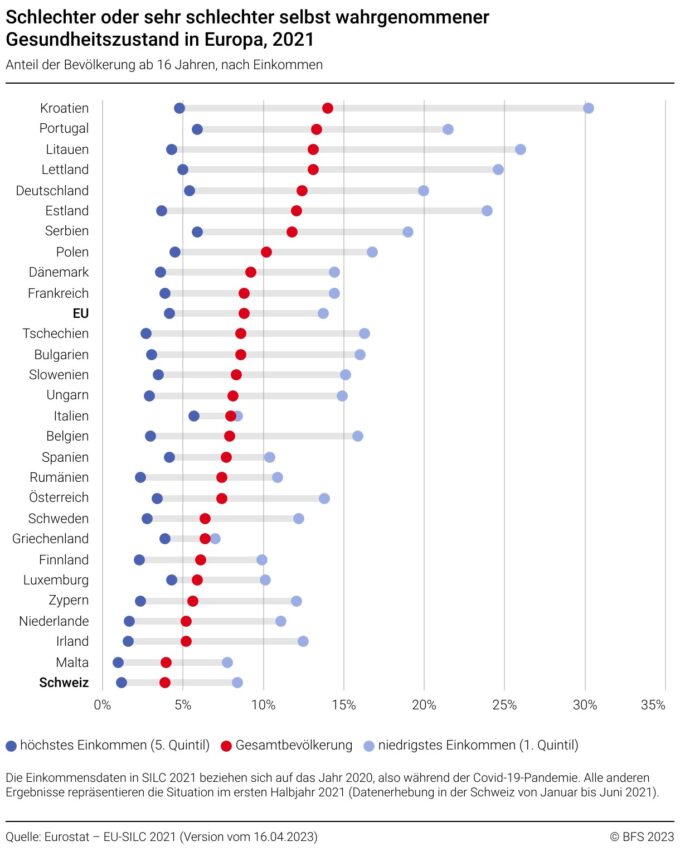Health status in Switzerland better than in Europe
Almost three quarters of the Swiss population felt happy most of the time or all the time in 2021. Only 3.9% rate their state of health as poor or very poor. This is lower than in any other country in Europe, according to the Federal Statistical Office (FSO).
Self-perceived health (see definition below) is the subjective assessment of one's own health and generally gives a good picture of the population's actual state of health, writes the FSO. In a European comparison, Switzerland is the country with the lowest proportion of the population that assesses its health as poor or very poor (3.9% compared to 8.8% in the EU). However, according to the FSO, this also depends on income.
8.4% of people in the lowest income group (the lowest 20% of the income distribution) would describe their health as poor or very poor. Only 1.2% in the highest income group (top 20% of the income distribution) would report this assessment. This difference between people in the highest and lowest income groups can be observed in all European countries, according to the FSO. In Germany and France, for example, 20.0%, and 14.4% of people in the lowest income group, respectively, rated their health as poor, while in the highest income group this was only 5.4%, and 3.9%, respectively.
Social disadvantages and health status
According to the data, there are differences in self-perceived health status in Switzerland according to education, income and income poverty. The influence of social disadvantages is accentuated with increasing age. For example, according to the FSO, people aged 50 and over with no more than a compulsory school-leaving certificate rate their health as poor or very poor twice as often (12.1%) as people who have completed their highest level of education at upper secondary level (5.9%). Compared to persons with tertiary education (3.2%), i.e., higher vocational education, persons with at most a compulsory school leaving certificate were almost four times more likely to be affected. Also, people aged 50 and over with foreign nationality (11.1%) were significantly more likely to report their health as poor or very poor than people with Swiss nationality (4.7%), it further said.
Majority of the population with good mental well-being
73.4% of the Swiss population said they felt happy all or most of the time in the four weeks prior to the survey. The proportion of people who felt discouraged or depressed all or most of the time was 5.9% and fell with increasing level of education and income.
Body mass index highest among those with low education
The level of education is reported to have a significant influence on the proportion of overweight or obese individuals. Those with at most a compulsory education (17.5%) were twice as likely to be affected by obesity than those with a tertiary education (9.0%). In contrast, other social disadvantages would have a smaller influence on body weight.
Overweight and obesity, self-perceived health status, and psychological well-being would be closely related. Individuals affected by obesity were significantly more likely to rate their health as poor or very poor (10.1%) compared to normal weight individuals (2.6%). They were also less likely to report being happy all the time or most of the time (69.2%), compared to those with normal weight (75.6%), the media release concludes.
Source: FSO, more info about this topic here

What means what?
The Self-perceived health is influenced by the impressions or opinions of others
influences, but is the result of a person's reflections regarding his or her own
Beliefs and attitudes. The question refers to health in general and
not on the current state of health, since non-transient health
complaints are to be measured.The Body Mass Index (BMI) is calculated by dividing the body weight (in kilograms) by the
Body height (in meters) divided by the square; overweight: BMI between 25 and 29.9; obesity:
BMI ≥ 30.Financial Poverty can be defined according to two approaches: the absolute and the relative
Approach. In both concepts, only the income situation is taken into account, without any
any assets (income poverty).The Poverty rate is based on an "absolute" limit: According to this, persons are considered poor if they do not have
have the financial means to provide the services necessary for a socially integrated life.
to acquire goods and services. The poverty line used is derived from the guidelines
of the Swiss Conference for Social Welfare (SKOS). It is composed of the
basic needs for living, individual housing costs and 100 francs per month per
person aged 16 and over in the household for other expenses. The poverty line is calculated with the available
Household income compared.The At-risk-of-poverty rate is based on a "relative" limit: The following are considered to be at risk of poverty
Individuals with incomes significantly below the usual income level in the relevant
country lies. Poverty is thus seen as a form of inequality. In accordance with the agreement
the European Union sets the at-risk-of-poverty threshold at 60% of the median disposable
equivalent income.The Gross household income includes all incomes of all members of a private household.
together. This includes income from employed and self-employed
Gainful employment, pensions and social transfers, returns on assets, alimony payments, and other
regular transfer income from other households.The disposable household income is calculated by deducting from gross income the
mandatory expenses are deducted. These include social security contributions, taxes,
Health insurance premiums for the basic insurance, alimony paid and other regular
maintenance contributions to be made.The Equivalent disposable income is calculated on the basis of the disposable household income
calculated by applying an equivalence scale to the size and composition of the
households is taken into account: The oldest person is weighted at 1.0, each additional person from 14
years with 0.5 and each child under 14 with 0.3. This takes into account the savings
which result from the joint management of a household with several persons.
result.









